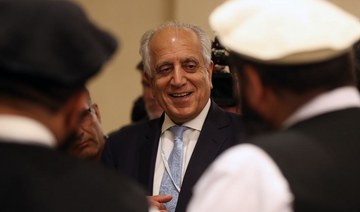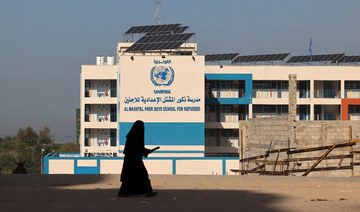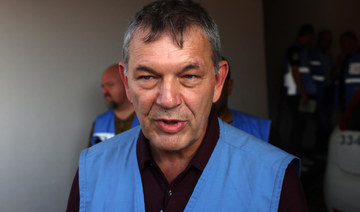PESHAWAR: The 9/11 attacks shocked the world as its only superpower had never before suffered an assault on this scale. One of the targets, the World Trade Center — with its famous twin towers — represented the strength of the US economy. The Pentagon, the other target, projected US military might.
When the administration of then-US President George W. Bush concluded that Al-Qaeda, headed by the late Osama bin Laden, was behind the attacks, it declared a “war on terror” and invaded Afghanistan.
The stated aim was to bring Bin Laden and Al-Qaeda to justice and prevent the emergence of other terrorist groups. Afghanistan’s Taliban regime, dominated by the majority ethnic Pashtuns, was also a target for harboring Bin Laden and other Al-Qaeda members.
The US invasion on Oct. 7, 2001, was not unexpected. The US had been demanding that the Taliban hand over Bin Laden because it considered him the mastermind of the 9/11 attacks. The Taliban’s supreme leader, Mullah Mohammad Omar, had asked for evidence of Bin Laden’s involvement.
Generally, the Taliban leadership continued to believe that Al-Qaeda and Bin Laden, who was a wanted man, could not have pulled off the attacks. Pakistan, which had very close ties with the Taliban, tried but failed to persuade Omar to agree to a compromise with the US over Bin Laden in order to avoid an invasion.
Taliban-ruled Afghanistan was an isolated and sanctioned country. Besides Pakistan, only Saudi Arabia and the UAE had recognized the Taliban regime, though they had become increasingly frustrated with its extremist policies.
The militant group had earlier refused a request by Pakistan and rest of the world not to destroy two 6th-century giant statues of Buddha carved in the mountainside in Afghanistan’s Bamiyan province.
Though the Taliban had extended its control to nearly 90 percent of Afghanistan by the time 9/11 happened, resistance to its rule had not fully collapsed.
Ahmad Shah Masood, the former mujahideen commander and defense minister, remained defiant, as did other anti-Taliban fighters. Masood was killed two days before the 9/11 attacks, in the northern Takhar province in a suicide bombing allegedly carried out by Al-Qaeda.
The Taliban’s tough measures had generally improved security in the areas it controlled, but there were frequent complaints of human rights violations by its fighters, particularly against the Hazara Shiite community.
Throughout Taliban rule from September 1996 until the fall of its government following the US invasion, the group had been fighting the Northern Alliance of mostly non-Pashtun ethnic minorities. Defeating its rivals was the focus of the Taliban’s attention, and the reason for the lack of a socioeconomic program that could address the concerns and needs of the Afghan people.
Certain Taliban decisions generated controversy. The move to stop girls aged above 9 from going to school was widely criticized, and the argument that the regime did not have the resources to manage separate schools for girls was unconvincing.
The ban on women working outside the home was criticized as it affected widows and those desperately in need of an income to run households. Capital punishment in public places further sullied the Taliban’s image. Executions, stoning to death and mutilations, including cutting off the limbs of those convicted of robbery, spread fear among the people.
The Taliban religious police was dreaded as it enforced rules on the spot. Women with uncovered faces and clean-shaven men were humiliated and punished on the streets and in marketplaces. The Taliban defended these decisions by arguing that lawlessness in Afghanistan could only be overcome by tough punishments. Its rule also saw certain achievements. Peace was restored in most parts of the country after mujahideen misrule and infighting.

Roadside checkpoints set up by mujahideen gunmen to rob passengers were dismantled. This enabled free movement of vehicles transporting passengers and goods, and won support for the Taliban from traders and transporters. With one decree issued by Omar, opium-poppy cultivation was eradicated from almost 85 percent of Afghanistan under the group’s control.
The fall of the Taliban was as quick as its rise. US forces used airstrikes to pound Taliban positions and force its fighters to hastily retreat. The US military helped the Northern Alliance make territorial gains.
In northern Afghanistan, Taliban fighters — cut off from their supply lines and bases in the south — surrendered to Uzbek warlord Abdul Rasheed Dostum following a deal that they would not be handed to the US. But senior Taliban members were handed over to the US and sent to Guantanamo Bay prison.
By late November 2001, Taliban fighters had mostly retreated to their spiritual capital Kandahar, where Omar reportedly escaped on a motorbike. Many Taliban leaders took refuge in neighboring Pakistan. The Al-Qaeda members led by Bin Laden fled to Tora Bora in Nangarhar province, and those who survived ferocious US airstrikes crossed over to Pakistan.
By early December 2001, the Bonn conference on Afghanistan had prepared a post-Taliban roadmap for the country and installed Hamid Karzai, a low-level mujahideen leader who had fought occupying Soviet forces, as interim president. Democracy was introduced, presidential and parliamentary elections began to be held, and the traditional Loya Jirga (grand assembly of elders) was called whenever issues of national importance needed to be resolved.
The country soon had a vibrant press and a vocal civil society. More children, particularly girls, started attending school, higher education opportunities and health-care facilities were extended, and legislation was passed to guarantee women’s rights. However, unabated violence negated some of the gains. During his first visit to his native Kandahar in December 2001, Karzai survived a Taliban attack.
It signaled the start of the Taliban insurgency, which strengthened in subsequent years and became a major threat to the Afghan government and US-led foreign forces by 2005.
In 2003, the US invaded Iraq and focused its attention on this new battleground instead of Afghanistan. Despite Omar’s death in April 2013, and the killing of his successor Mullah Akhtar Mohammad Mansoor in a US drone strike in Pakistan’s Balochistan province in May 2016, the Taliban insurgency continued to gain momentum under the new supreme leader, Shaikh Haibatullah Akhunzada.
The Taliban controls more territory now than at any time since the US invasion nearly 18 years ago.
The US finally accepted the Taliban demand for direct peace talks in July 2018 without the Afghan government’s involvement, but making peace remains a daunting challenge.
US President Donald Trump’s move on Sunday to cancel the expected peace agreement with the Taliban has contributed to uncertainty and raised concerns over continuing bloodshed.
As it turned out, 9/11 was the last major terrorist attack against the US, which took unprecedented steps to thwart further ones.
But Afghanistan continues to suffer from unending violence, even though none of the 9/11 attackers were Afghan.

























